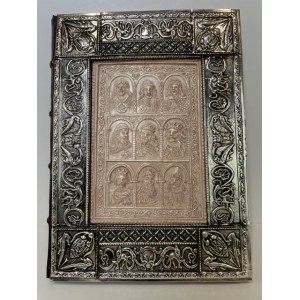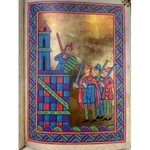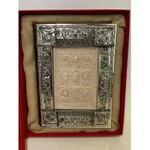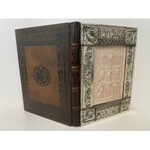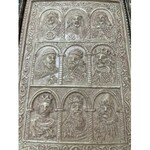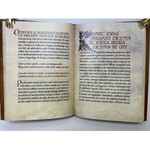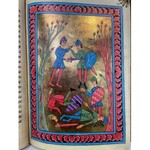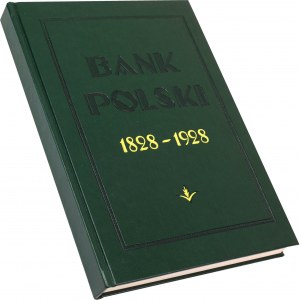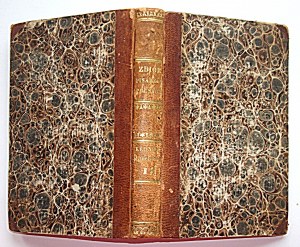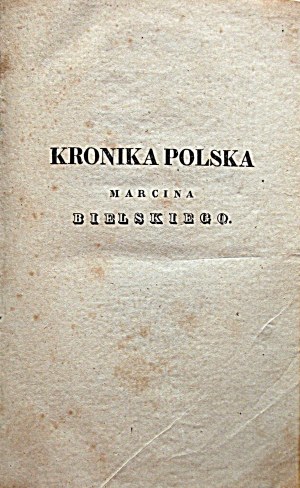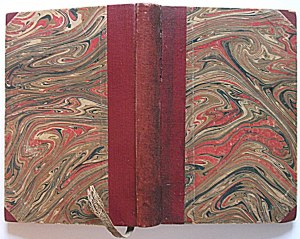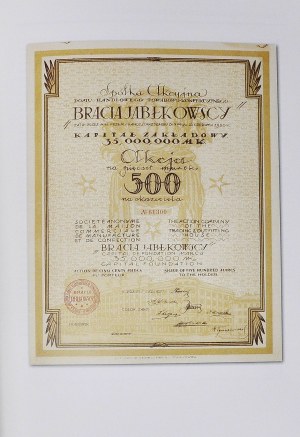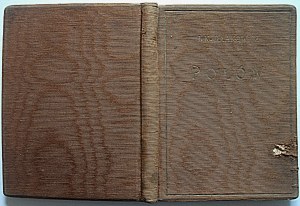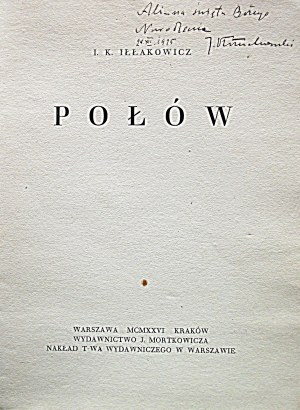BINDING:
The binding is modeled after the most luxurious medieval books, including Emperor Henry II's sacramentary and the Fulda Evangeliary. The folds are sewn by hand, (as they were centuries ago) with cotton thread on the bindings. The capital, which is a special fabric applied to the spine of the book, is also sewn by hand. With a relief depicting rulers from the Piast dynasty. The first row from the left is the legendary Piast - the founder of the dynasty, along with a circle symbol referring to his nickname. Next, in the center, is his son Siemowit, along with the Slavic symbol, while on the right is Piast's grandson Lestek, also with the Slavic sign. The middle row from the left is formed by Siemiomysł with the Piast eagle, and in the middle is Mieszko, the first historical ruler of Poland, with an emblem taken from a denarius he minted. On the right is Boleslaw the Brave with a bird from a coin he minted. The last row is formed from the left by Boleslaw the Bold, Mieszko III and Boleslaw the Wrymouth - by each figure respectively: a knight from the obverse of Boleslaw the Bold's denarius, a knight from Mieszko III's horse seal and a knight defeating a dragon from Boleslaw the Wrymouth's denarius. The whole piece is clad in sheet metal decorated with a braided bordure with an ornament taken from the Gniezno Doors.
PAPER: imitating parchment
FONT AND INITIALS:
This book was written in a font specially created for it in Pelplin, where the Cistercian monastery is located. It is modeled on a 12th century font - the Caroline, hence the name - the Caroline of Pelplin. Carolina itself owes its name to Charlemagne, who had a new typeface developed that was more versatile and legible. Today's commonly used fonts are just derivatives of caroline.
There are two types of initials in the text - ornate, capital letters that begin chapters or subchapters. The most ornate are those starting chapters or letters between them. They are handmade in the Romanesque style prevailing in the 12th century. These initials are characterized by lush weaves of plant stems and branches, dotted with buds of flowers or foliage. Some parts of the letters are formed by winged birds, snakes or dragons. Human figures are also often woven in as a decorative motif. Less ornate initials, made in red paint in large letters, open individual subsections of the chronicle. They serve to separate parts of the text, just like today's dots or dashes.
In the chronicle, miniatures are illustrative, and also show what the style of miniatures was like in the 12th century. They were modeled on the most valuable manuscripts of the 11th and 12th centuries, such as the Kruszwitz Evangeliary, the Pultus Codex and the Sacramentary of Tyniec. Miniatures in bibliophile version printed in gold ink using serigraphy technique.
LIST OF MINIATURES:
1. eating Popiel by mice
2. recovery of Mieszko's eyesight during the shoeing ceremony
3. Mieszko and his wife - Dabrowka
4. the redemption of St. Adalbert's body by Boleslaw the Brave
5. the Gniezno convention. Emperor Otto III gives Boleslaw the Brave the spear of St. Maurice, in return he receives the arm of St. Adalbert
6th Gniezno congress - feast.
7. conquest of Kiev - Boleslaw the Brave strikes the Kiev gate with a sword. This sword, later known as Szczerbiec, was one of the coronation insignia of Polish kings
8. poor peasant referring his problems to Boleslaw the Brave surrounded by the court
9. the battle against the Rus. At the top a feast in the camp of Boleslaw the Brave, at the bottom the battle itself
10. death of Boleslaw the Brave (top) and mourning for him (bottom)11. Boleslaw the Bold, also known as the Generous, bestows gifts on a poor cleric
12. execution of Bishop Stanislaus on the orders of Boleslaw the Bold, also known as the Mad One
13. Ladislaus Herman and sons - Zbigniew and Boleslaus the Wry-mouthed
14. young Boleslaw the Wry-mouthed kills a boar himself while hunting
15. invasion of Wroclaw land by Czechs
16. battle between Poles and Moravians ended in a bloody draw
17. siege of Czarnków castle in Pomerania by Boleslaw the Wry-mouthed - war machines: catapult and siege tower
18. invasion of Emperor Henry IV: harassment of German troops by Boleslaw the Wrymouth by day and night - that's why the miniature shows both the moon and the sun
19. invasion and sacking of barbarian Prussia by Boleslaw the Wry-mouthed



